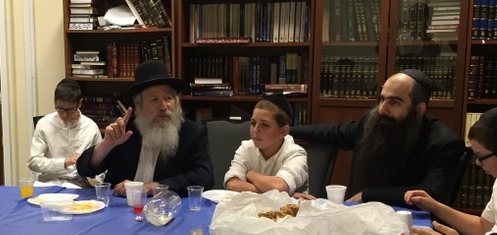
Reprinted from N’Shei Chabad Newsletter, Kislev 5766
Anyone with an adolescent son or daughter faces challenges quite different than previous generations. The tools of yesteryear need to be sharpened and new approaches added in order to weather the typically stormy teenage period in today’s society. The success we all desire for our children is built on a genius strategy that is a simple and ancient time-tested truth. Yemin mikareves usmol docheh. The right (kind) hand brings closer and the left (strict discipline) hand pushes away. Rabbi Gil Hami, principal of Mesivta Lev Tmimim Lubavitch, located in Monsey, shares what he has learned from his years in chinuch, painting a picture of what we confront and how to best respond. -Ed.
- Yossi certainly wishes to be in the Rebbe’s yeshiva and grow in his chas- sidishkeit, but can’t find the right yeshiva to fit his personality, skills and disposition.
- Moishe wears his hat and jacket in the street every day, does three prokim Rambam, and only has niggunim on his iPod– but he doesn’t do too well socially. Without friends, he is left feeling sad and worthless and sometimes can’t learn. He’s a regular boy, he just needs some guidance and caring from his teachers to help him over this rough patch.
- Shmuli is extremely smart and knows every Tosafos. But he is filled with tre- mendous energy and early on earned the title of class clown. He repeatedly is kicked out of class for his raucous behavior. He now resents yeshiva. A simple remedy is regular strenuous physical exercise, yet little is offered.
- Mendel grew up in a town without a day school. Gemara skills are almost non-existent, and he has been exposed to a flood of worldly ideas. But inside he is a Tomim ready to be in the Rebbe’s yeshiva. The “good” schools won’t accept him but if he goes to a “lenient” yeshiva he knows (or rather his parents know) he’ll certainly go down the wrong path.
- Beryl is growing up in Kan Tzivah Hashem Es Habrachah. In addition to absorbing the kedushah of the Rebbe’s shechunah, he also absorbs foreign street influences. Unfortunate peer alliances contribute to his discomfort with the traditional approach to issues such as dress, study schedules, modern tech- nology, music and the like. He asks why his parents and teachers won’t let him dress the way he wants or have the phones his friends have.
What these boys have in common is the all-important basic need to find the right environment that will guide them up the right path to being a tamim. G-d forbid, with- out the warmth and structure they need, they may come to resent and turn their backs on yeshiva and what it stands for.
Make no mistake: The yeshiva, the hanhalah, and the learning environment represent the Eibershter and Yiddishkeit! If our sons are happy with the yeshiva, they are likely to enjoy their Yiddishkeit, be close to the Rebbe, and live their chassidishkeit; in brief, Hashem will be real to them.
This cannot be repeated enough and must be written on the hearts and minds of each mother and father, teacher and mentor: large doses of ahavah and varemkeit (love and warmth) must be administered all the time.
When a talmid feels he is cared for and that he matters–and when he is in a place that he enjoys and even has fun in– then he can be given a healthy dose of gevurah. And the correct gevurah is justas crucial to his success:
Chassidishe caring begins when you feel that each bachur has infinite value–not because of his achievements, but based on his essen- tial being–a chelek Eloka mimaal mamash, his neshamah which is a part of Hashem. And when he feels this from his teachers, rebbis, and older Shluchim, and senses that they believe in him and in his ultimate worth, then he believes in himself and his ability to achieve–academically, and spiritually–more than he originally thought possible. Then and only then is he a keli (vessel) to smol docheh. What sort of gevurah?
Kedushadik gevurah is expressed in clear boundaries and expectations. Those boundaries that in the past we took for granted must now be actively demonstrated, explained, taught and enforced. In yeshiva this expresses itself in things as simple as properly enforcing shmiras hasedarim, proper dress for a tamim, lashon nekiah (refraining from inappropriate language), shmiras einayim (from internet, movies, etc.) and behaving with derech eretz in class. However, the key to having the bachur accept these restrictions and not rebelling or resenting is this foundation of ahavah and chessed. In yeshiva this is expressed in ways like helping a boy feel “noticed,” having teachers who first seek to understand before making themselves understood, having a fun and happy atmosphere, and, yes, even trips.
In short, the emotional wellbeing and happiness of a child is the foundation for his personal and academic success. The yeshiva must build a safe and nurturing environment of yiras Shamayim and chassidishkeit. In such an environment the bachur will grow to love learn- ing, challenge himself to go beyond his current level, and excel as a human being and a chossid. In the Rebbe’s words,”Chinuch must come through love and connection, as we can tangibly see that education through revealed love is more effective than education through fear and awe.” (Sefer Hasichos 5750 pg. 194)
